Greater or Lesser Scaup? This question comes up frequently during the winter along the Texas Gulf Coast. The confusion starts with the similar appearance of the duck Genus Aytha. In North America we have 6 possible members of this Genus of diving ducks. This includes the Canvasback, Redhead, Ring necked Duck, Tufted Duck and the Greater and Lesser Scaup. The Tufted Duck is a rare vagrant in the US and unknown in Texas. For the scope of this piece we will avoid the Tufted Duck altogether. The Canvasback is structurally dissimilar and not easily confused. The Redhead, while structurally similar, shows a red head (male). Another diver in the Genus, the Ring necked Duck is easily separated from the two Scaups by the presence of a white band with a black tip on its gray bill.
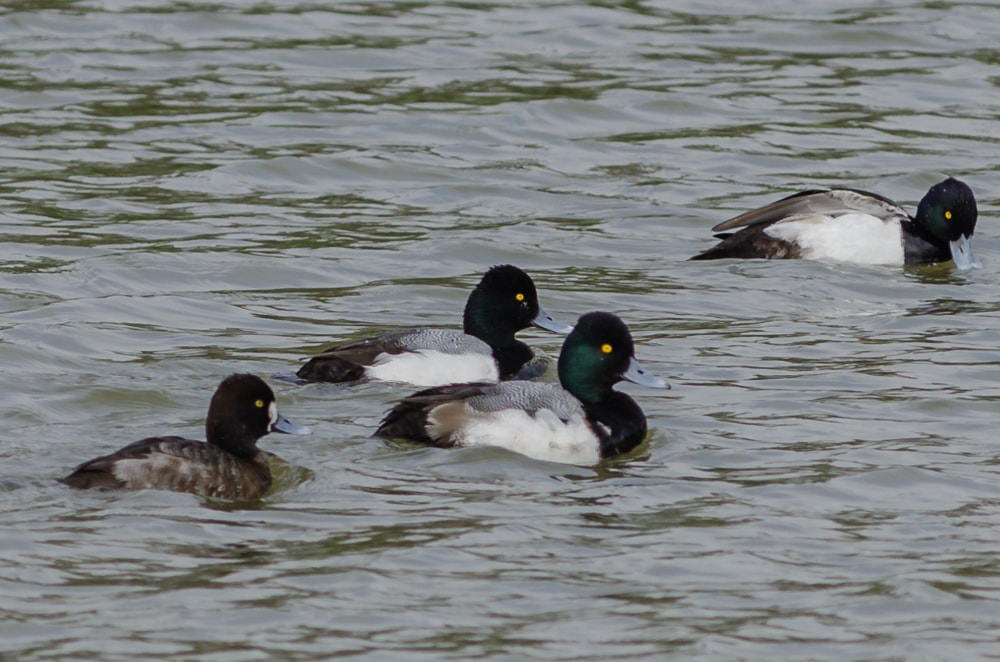
The two Scaups, while very similar, can present ID problems in the field. However with a little practice and close observation they can be separated with some reliability.
Distribution
Distribution of the two Scaups can be a helpful clue. The Lesser Scaup breed in central to western Canada and Alaska. It is the most common waterfowl breeder there. In the US the breeding range is limited to parts of Washington, Oregon and parts of N. California. The majority of the population winters along the Gulf Coast and that my focus. The Greater Scaup is a cosmopolitan tundra breeder and in the US breeding is limited almost entirely to Alaska. Some Greater Scaup spend winter along the Texas Coast and usually can be found along side Lesser Scaup.
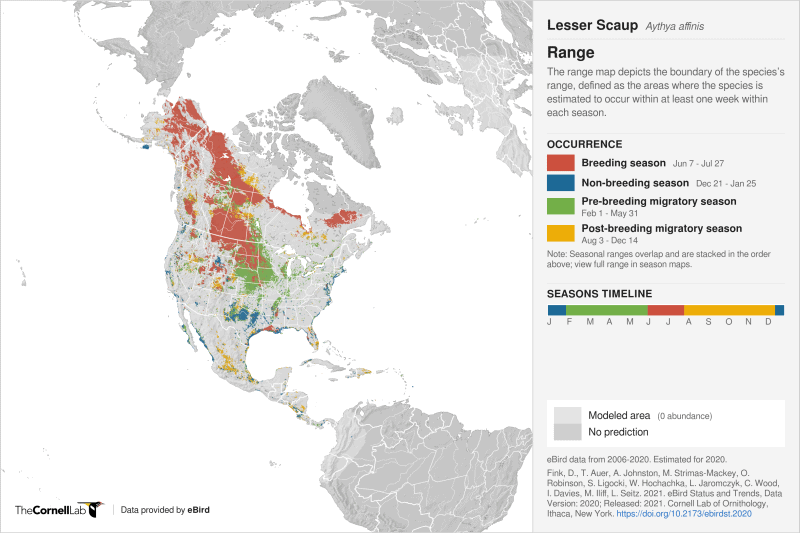

Identification
At first glance both of the Scaups display a very similar in appearance. The Greater is slightly larger (about 10%), and weighs more (about 20%). Size is difficult to differentiate unless both species are present and can be compared. The keys to field separation of the two Scaups focuses primarily on the shape of the head and bill characteristics. The Lesser Scaup has rear peaked head and tends to hold it higher in the water. The area at the back of the head appears more flat. The Greater Scaup has an more rounded front loaded head and is rounded in the rear also. Care must be taken to determine the actual head shape when the birds are at rest and not actively diving. If you get a front view the cheeks appear more robust on the Greater Scaup and give the appearance of a wider frontal view.
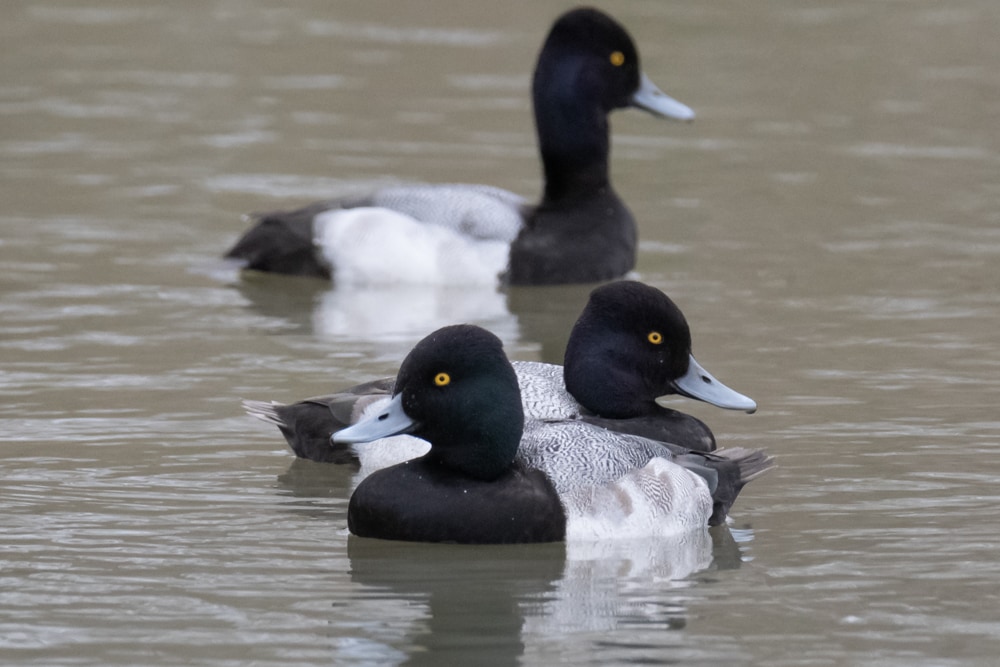
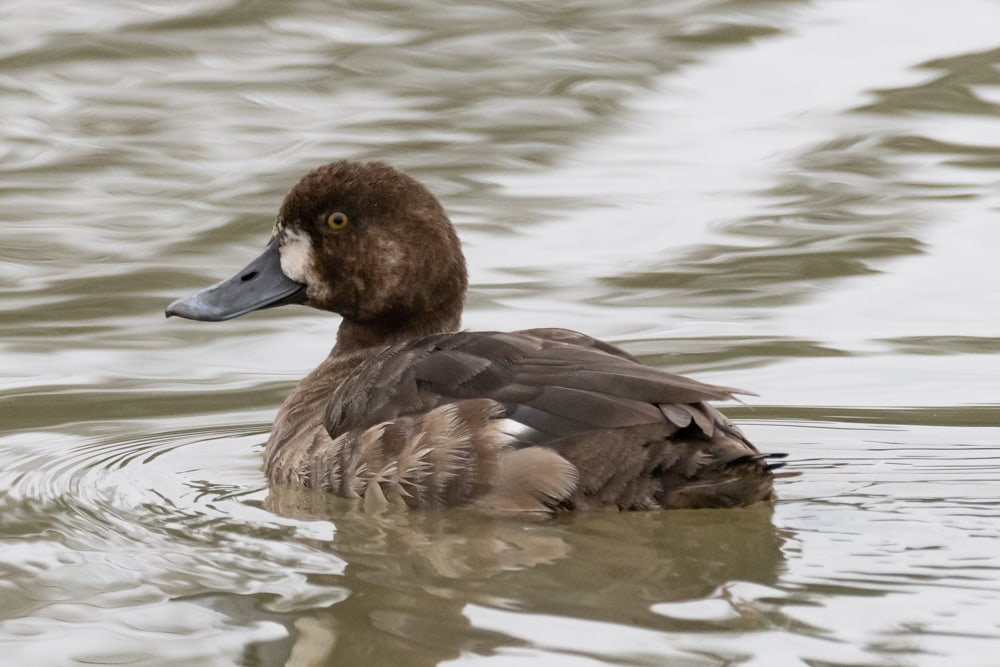
In addition to the head shape, bill size and characteristics are useful to reliably separate the species. Note the relatively greater width and depth of the Greater Scaup bill in the images above. On some male Scaups, the “nail” – the the tip of the bill, also tends to be larger and the black color can extend on the bill itself. The nail in the male Lesser Scaup is smaller and rectangular in shape. The Greater Scaup nail color may extend across the tip of the bill to give the impression that it is triangular. The width of the nail on Lesser Scaup is about half the width of the Greater Scaup.
Both species show a white wing stripe in flight with the Greater Scaup having a longer stripe extending into the primary flight feathers. The Lesser Scaup stripe is generally limited to the secondaries. The wing stripe field mark can vary with population, age and molt. Another clue that can be useful is the male Greater Scaup generally shows a white rectangular flank with limited stippling, whereas the Lesser tends to be more heavily marked. This too should be viewed with some caution as it can vary with molt.
Some literature points to the head color sheen in good light as an identifier. The male Greater Scaup shows a green sheen in good light and never purple. Unfortunately the Lesser Scaup can show either green or purple and this field observation should also be used with caution. The example image below shows a green sheen on what is clearly a Lesser Scaup.
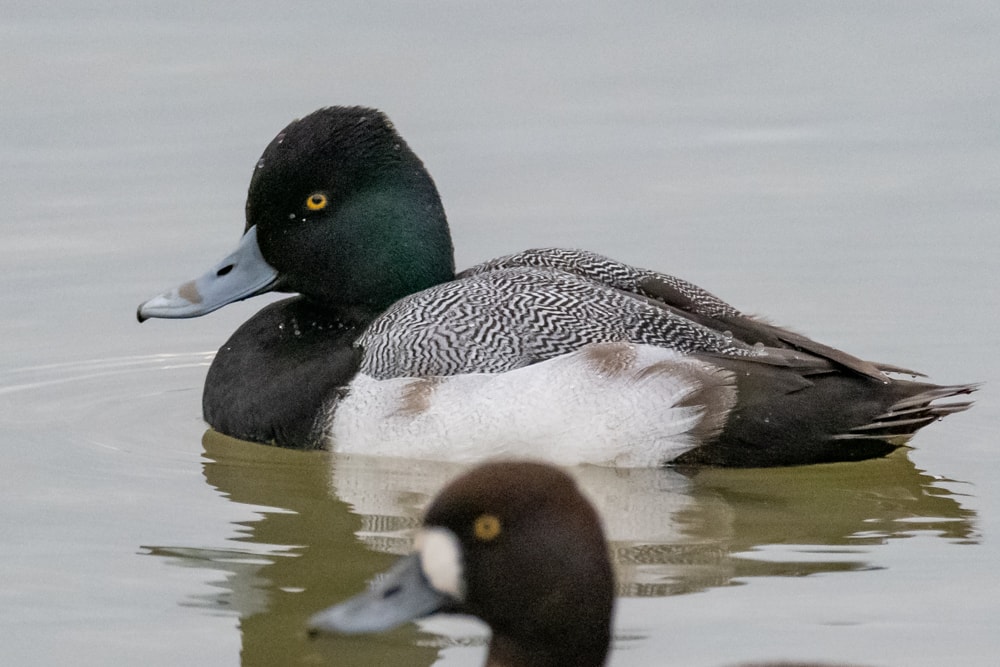
To add to the confusion the image below shows two birds that are clearly male Lesser Scaup. The bird on the left shows a green sheen and the one on the right shows a purplish sheen. I personally don’t find this to be a reliable field mark.
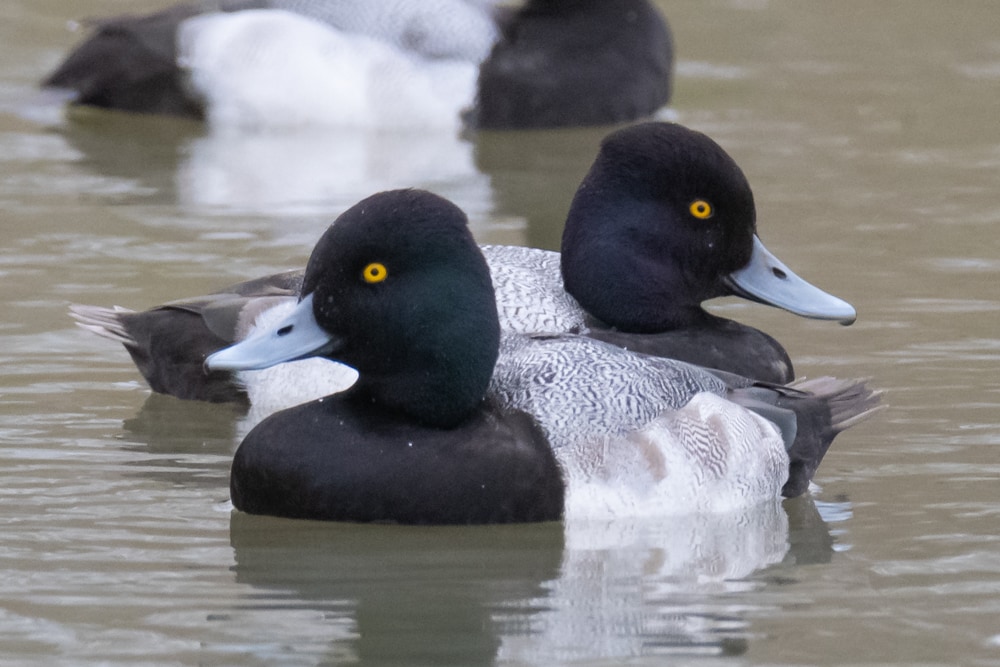
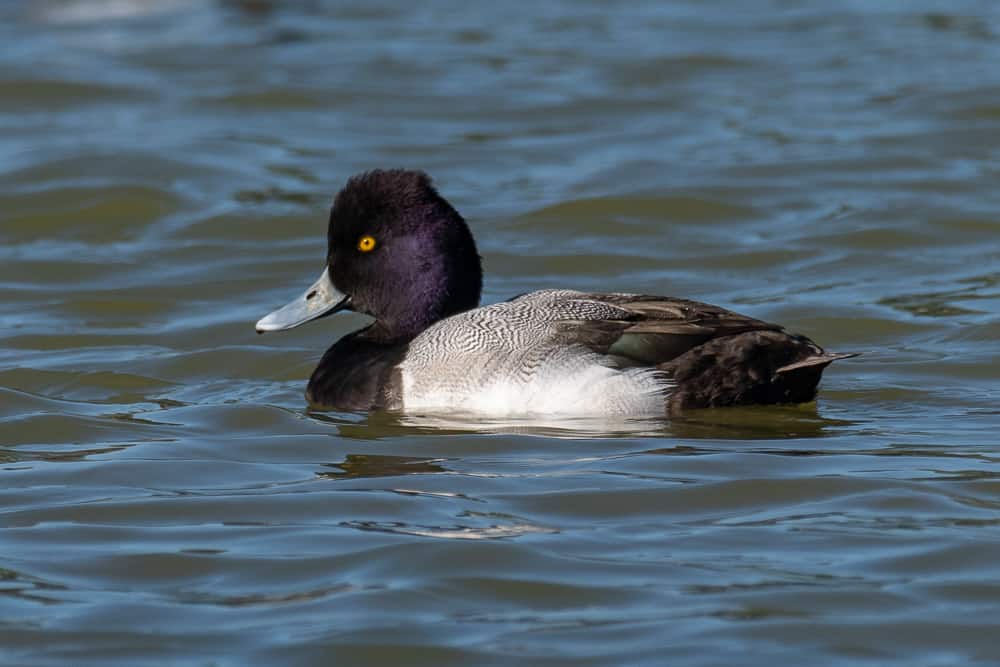
So, Greater or Lesser Scaup?
If you live along the Gulf of Mexico and see flocks of Scaup, take the time to look at them as individuals. Observe the birds at rest if possible, not actively feeding. Pay close attention to the head shape, and bill size, shape and depth. The birds differ in size and when both species are present, it is readily apparent the Greater Scaup is a slightly larger and more robust bird. Although the Greater Scaup is present during the winter in Texas, don’t expect to find them in great numbers. However if you take the time to look at the reliable field marks, you may just find a few this year. The key to correct identification is to use ALL of the visible field marks for confirmation.
The image below shows both species in close proximity. This demonstrates the difference in resting Scaup and clearly shows the difference in bill size and depth, body size and head shape.

The next image highlights the obvious difference in bill size and shape. Note the larger bill on the background bird.


The following image shows a robust head, large bill with “chubby cheeks”. Is it a Greater or Lesser Scaup? Without using all the field marks it can be difficult to determine. Scroll down to the next image to find the answer.

The following image was take just seconds after the one above. The foreground duck is the same as above, but viewed laterally. It clearly shows a Lesser Scaup as are the other two birds. Neck extension changes the width in the cheek area.

Now look at the image below. The foreground Scaup is heavy jowled, and has a triangular shaped black nail. Is it a Greater Scaup? However without a lateral view of the head shape, it is not possible to reliably make that determination. A side view of this duck may have made a difference. As such this one needs to be identified as just “Scaup”.

I trust that you find this post and media informative to highlight the difference between these similar species.
I have also posted additional avian images. These consist of posts about individual species and albums by year and location. These are found at Birds I Have Known
Comments are always welcome.
eBird. 2022. eBird: An online database of bird distribution and abundance [web application]. eBird, Cornell Lab of
Ornithology, Ithaca, New York. Available: https://www.ebird.org.
Its May and I spotted some ducks that appear to be ring neck or scalp in the long island sound. I have pictures I can load.
Both species can be found in your area. Try this link to help you narrow down which. https://www.allaboutbirds.org/guide/
On Monday, 1/2/23, I led a group of birders on a Christmas Bird Count in the Santa Fe Watershed, on the eastside of Santa Fe, NM. On a small pond & rivulet of a reservoir, we spotted a pair of male Ring-necked Ducks three (3) Green-winged Teal. There was also a “mystery duck” that was congregating & diving with the two (2) Ring-necked Ducks. From a 1/4 mile distance it was quite difficult to see a tell-tale sign of a distinct marking on the mystery diving duck. I remember that it was smaller in size in comparison to the Green-winged Teal, as well as the Ring-necked Duck. It had a purplish rounded head & a white wing bar, probably on a secondary, on it’s lower side. I surmised that it must be a Lesser Scaup. Now that I think about it, it appeared to be a female but it definitely wasn’t a Ring-necked Duck. Sorry, no pictures were taken of the ducks.
Is it usual to see the Lesser Scaup in a flock or all by itself? Any thoughts on why would a young Lesser Scaup possibly be hanging out with a different species? Is an immature, first year Lesser Scaup notably smaller than an adult male Ring-necked Duck? Please advise. Oh, I really enjoyed your feature on “Greater or Lesser Scaup ID – What’s the difference?” & all of the photos. Quite insightful. Thanks.
Dissimilar Duck species frequently associate. Lesser Scaup and Ring-necked Ducks are very similar in size with overlap across sex and age.
Do they migrate a great altitudes in large numbers over the east coast of Flordia?
Lesser Scaup are fairly common in Florida during migration and winter. Most often observed in large numbers foraging in water bodies. Greater Scaup not common.